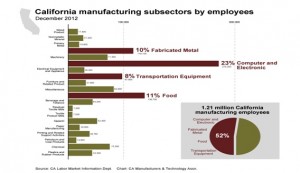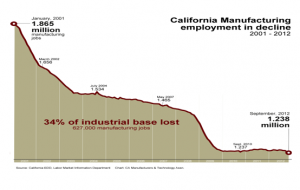Since there is no IMTS show being held in the United States this fall, and FABTECH, to be held November 18-21, 2013 at McCormick Place in Chicago, IL is a long way from southern California, the best opportunities to attend a manufacturing trade show for southern Californians are:
Design-2-Part Show – October 9-10, 2013 – Pasadena Convention Center
WESTEC – October 15-17, 2013 – Los Angeles Convention Center
The Southern California Design-2-Part Show attracts thousands of design engineers, manufacturing engineers, managers, and buyers to meet local and national job shops and contract manufacturers to source custom parts, components, and services. With over 175 exhibiting companies, this year’s show will be D2P’s largest show ever in Pasadena.
The show in Pasadena is one of eleven Design-2-Part Shows owned by the Job Shop Company that either have or will take place in 2013 in major manufacturing hubs within the United States. The show policy since inception over 38 years ago has been to exclusively feature job shops and contract manufacturers with manufacturing operations in the United States. Companies that do not have facilities in the U.S. are not permitted to exhibit.
I will be presenting a seminar titled “Returning Manufacturing to America Using Total Cost Analysis,” on October 10, 2013 at 11:30 am at the show. The one-hour session is free to all show attendees of the Southern California Design-2-Part Show.
The Job Shop Company’s press release states: “Ms. Nash-Hoff’s presentation will cover how supply chain dynamics, labor costs and fuel costs are changing the status quo. She will present a true understanding of the “Total Cost of Ownership” (TCO) concept including what most executives miss when analyzing TCO. The highlight of the presentation will be several real case success stories of companies that have returned work to the U.S. from offshore suppliers and the lessons that are learned from these real world practitioners.”
“Having Michele Nash-Hoff speak at our design and contract manufacturing show is a perfect fit,” said Jerry Schmidt, President of the Design-2-Part Shows. “Attendees can hear Michele justify bringing work back to the states and then they can walk the show floor and find the high-quality U.S. suppliers they need to solve their challenges.”
“Michele Nash-Hoff is President of ElectroFab Sales, a manufacturers rep agency, and author of Can American Manufacturing Be Saved—Why We Should and How We Can. Her blog articles appear on the Huffington Post and Industry Week magazine’s blog.” For the past two years, “Ms. Nash-Hoff has been speaking on behalf of The Reshoring Initiative, a nonprofit, industry-led organization dedicated to bringing work back to the U.S. from overseas. The Initiative is achieving its goals by helping manufacturers recognize that local production or sourcing may actually reduce their TCO (Total Cost of Ownership) of purchased parts and tooling. The Reshoring Initiative was founded by Mr. Harry Moser who was named to Industry Week magazine’s Manufacturing Hall of Fame in 2010 for this work.
Admission to the Southern California Design-2-Part Show is free to qualified industry professionals. For more information or to register for the show, visit www.D2P.com.
If you don’t live in southern California, don’t miss one of the other regional Design-2 Part shows still coming up. The rest of the fall schedule is:
Marlborough, MA October 30-31
Covington, KY November 20-21
WESTEC 2013 – October 15-17, 2013 – Los Angeles Convention Center
WESTEC is produced by SME (formerly the Society of Manufacturing Engineering.) Now, SME connects all those who are passionate about making things that improve our world. As a nonprofit organization, SME has served practitioners, companies, educators, government and communities across the manufacturing spectrum for more than 80 years. Through its strategic areas of events, media, membership, training and development, and the SME Education Foundation, SME shares knowledge to advance manufacturing. SME works together to make the future through exciting, interactive face-to-face events such as tradeshows and conferences, SME events serve as the manufacturing industry’s vital conduit. SME creates opportunities for people to showcase innovation, share knowledge, grow their businesses and build relationships
WESTEC has always been the West Coast’s “can’t miss” event, a technology showcase that helped generations of manufacturers grow their businesses. WESTEC is the region’s definitive manufacturing event and returns to the Los Angeles Convention Center Fall 2013 redefined and with renewed commitment to area industry.
The show is a true manufacturer’s think tank where creativity, vision, and strategy join forces to spotlight the promise of groundbreaking products for vital global markets. This is where you can meet experts who can help apply cutting-edge equipment, make sense of lean methods, and manufacture with composites, titanium, or other advanced materials.
WESTEC is where collaboration starts – a place to network, form relationships, and build partnerships. It is where technology takes center-stage, putting new developments, integration, and solutions right into your hands.
WESTEC is a showcase for the latest innovations from the leaders in manufacturing and where you can experience the people, technology and innovation that are redefining the future of manufacturing. Many technology breakthroughs of recent decades were unveiled at WESTEC.
The very latest technologies – from software, cutting tools to multi-tasking machines will be on display from top international equipment manufacturers. Plan to participate in WESTEC by registering at westeconline.com.
Another opportunity for manufacturers in the San Diego region to find local vendors is provided by CONNECT’s Nearsourcing Initiative, which focuses on assisting San Diego companies in need of outsourcing to take a closer look at our region’s local outsourcing cluster. The program includes workshops that educate our region’s innovation entrepreneurs on the benefits of contracting with local manufacturers, including reduced time to market, increased innovation and reduced risk and costs; and to assist San Diego innovation companies in need of outsourcing to Innovate Locally, Grow Globally – to connect and contract with qualified San Diego production resources.
The program ensures that business is not offshored unless necessary and keeps economic growth and job creation in our local region—which can be found in these case studies. The program also includes initiatives to market San Diego’s production capabilities and help local supply chains network, innovate and compete internationally. You can find more details on the program as well as access to the San Diego outsourcing community through The Connectory and the CONNECT Resource Guide.
The CONNECT Nearsourcing Initiative is led by a Steering Committee of Production Cluster leaders including Sharp HealthCare, D&K Engineering, Althea Technologies, Pharmatek Laboratories, Invetech, DD Studio, Leardon Solutions, BioLaurus, Solekai Systems, Clarity Design, the East County Economic Development Council, which owns and operates the Connectory – a database of 5,600 local production companies, the San Diego Regional Economic Development Corporation and intellectual property experts from Sheppard Mullin and Sughrue Mion.
There will be a Nearsourcing trade show in conjunction with the Connect with CONNECT networking event on October 30, 2013 from 3:00 pm – 5:00 pm at the offices of Knobbe Martens Olsen & Bear, 12790 El Camino Real, San Diego, CA 92130. You may register at http://connect.org/events/
I urge you to take the time to attend one of these events this fall if you are in the San Diego/southern California region. Now is the time to get on the bandwagon early to find local sources to “nearsource” or “reshore” by bringing back manufacturing to America. Hope to see many of you at one of these events!

